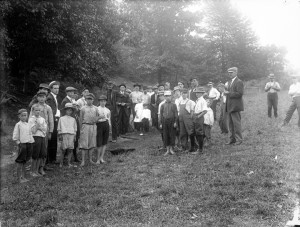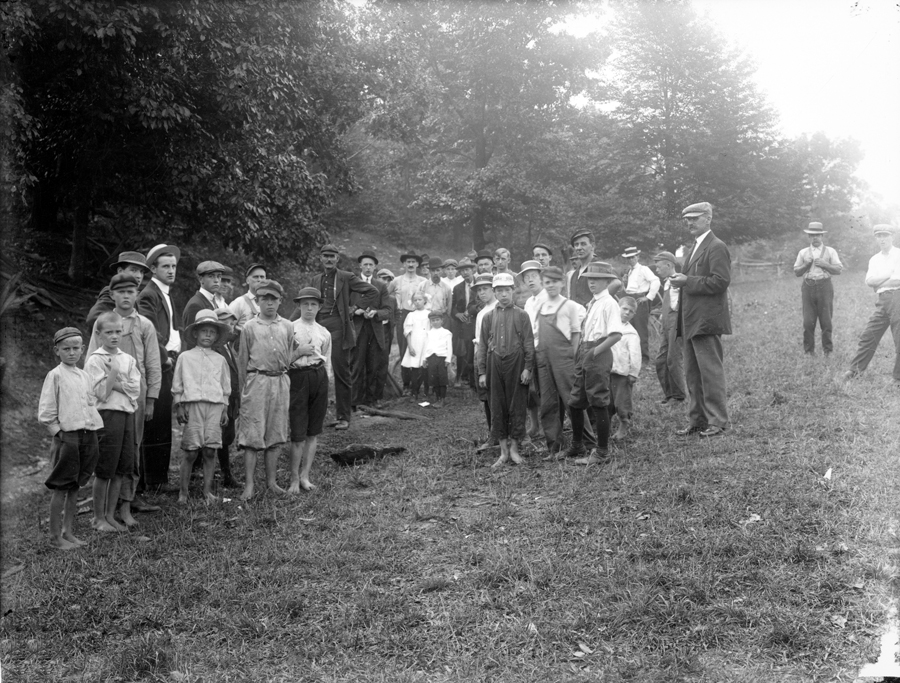Lynching
Essay
Lynching, the extralegal killing of a victim by individuals or a mob, notably by hanging or burning, was commonplace in the United States at the turn of the twentieth century. Though accounts vary, in the heyday of lynching following the Civil War, at least 3,500 incidents were recorded; more than 80 percent occurred in the American South and targeted African Americans. Though less frequently, lynchings also occurred in Pennsylvania, Delaware, New York, and New Jersey. Two of the most sensational incidents occurred in Wilmington, Delaware, in 1903 and Coatesville, Pennsylvania, eight years later.
In an incident dubbed by newspapers as the “Delaware Horror,” in June 1903 a mob watched as African American farm laborer George White burned alive on the outskirts of Wilmington. Accused of having assaulted a teenage girl and leaving her to die, White was kidnapped from the New Castle workhouse and returned to the site of his alleged crime as an angry crowd jostled for position. His plea for help—“Mercy, Master, Mercy”—went unaided and afterwards spectators retrieved souvenir body parts.
Philadelphia newspapers provided ample coverage of the episode and the efforts of local civil rights activist and A.M.E. pastor Montrose Thornton to hold the guilty accountable. They also published dozens of letters both praising and condemning the mob action. Like the one previously recorded racial lynching in Delaware (near Smyrna in 1867), no one was ever prosecuted. The Wilmington lynching was one of a half-dozen barbaric “spectacle lynchings” that occurred across the North in 1903. In retrospect, the Wilmington lynching has eerie similarities to events in Coatesville eight years later.

On Sunday evening August 13, 1911—“that quiet Sabbath evening,” W.E.B. Du Bois (1868-1963) wrote scornfully—an estimated two thousand people watched as Zachariah Walker was burned alive in a field just outside Coatesville, Chester County. Walker, a newly arrived African American laborer from Virginia, worked at the Worth Brothers Steel Company. He was accused of killing a popular white security guard in what might well have been an act of self-defense. As teenage boys piled more wood on the fire, Walker pleaded with his captors, “Don’t give me no crooked death because I’m not white.” When the deed was done, scores of people waited hours to retrieve souvenirs from the flickering embers.
The Coatesville lynching typified the well-orchestrated mob execution that historian Michael Pfeifer has summed up in the phrase “rough justice.” Like George White in Delaware, Walker was not afforded due process, and the formal administration of justice broke down completely. Chester County juries found the alleged perpetrators not guilty, and crowds cheered when the men and teenage boys emerged from the county court house in West Chester. Despite evidence, in both cases no one was convicted of a crime.
The most unusual characteristic of the Coatesville episode (and Wilmington, too) was its geographic setting beyond the American South. Coatesville was a prosperous northern steel town, and a community in the throes of significant social and economic change brought on by rapid industrialization and the sustained in-migration of both European and southern Black laborers. Racial and ethnic tensions were at their height in a borough already layered with deep class divisions. Much to the dismay of civil rights advocates like Du Bois, Ida Wells-Barnett (1862-1931), and T. Thomas Fortune (1856-1928), the Wilmington and Coatesville incidents were reminders that mob violence every bit as vicious as the worst southern atrocities could occur beyond the old Confederacy.
Lynchings were often underreported, and attempted lynchings, including two later incidents in Coatesville, often have been ignored in the history of racial violence. While accounts vary, African Americans were victims in six of the fourteen recorded lynchings in Pennsylvania history. Eight of the estimated ten lynchings in the rest of the mid-Atlantic region included Black victims. Though the total number of northern racial lynchings ebbed with the rise of organized resistance, the spreading pall of twentieth-century urban rioting in Philadelphia, Wilmington, Newark, and elsewhere, served as a reminder of racial violence as a persistent social reality.
The memory of lynching also persists. In the early 1990s a prominent resident of Coatesville proudly displayed to a historian a self-igniting miniature scaffold he had manufactured in homage to the lynching. And in January 2000, a white resident of the Juniata Park section of Philadelphia was convicted of the crimes of ethnic intimidation and assault for placing a makeshift noose around a Black co-worker’s neck. Although not as well publicized as the case of the Jena Six in Louisiana (2006), the incident in Philadelphia, like the scaffold, was another reminder of the insensitivity, blatant prejudice, and conflicting social fears that underlay the gruesome legacy of lynching and racial intimidation in the United States and the Greater Philadelphia region.
Dennis B. Downey, Ph.D., is Professor of History and Director of the University Honors College, Millersville University. With Raymond M. Hyser, he is the author of ‘No Crooked Death’: Coatesville, Pennsylvania, and the Lynching of Zachariah Walker (Urbana: University of Illinois Press, 1991; reprint 2011). (Author information current at time of publication.)
Copyright 2014, Rutgers University
Gallery
Backgrounders
Connecting Headlines with History
Links
- The Lynching of Zachariah Walker Historical Marker (ExplorePAHistory.com)
- Lynching in America: Statistics, Information, Images (University of Missouri-Kansas City School of Law)
- Without Sanctuary: Photographs and Postcards of Lynching in America (Collection of James Allen and John Littlefield)
- A Lynching Map of the United States, 1900-1931 (Slate.com)
- Philadelphia Inquirer Coverage of Coatesville Lynching, 1911 (Philly.com)
